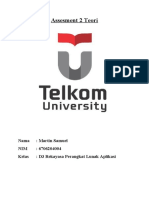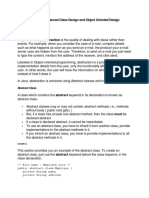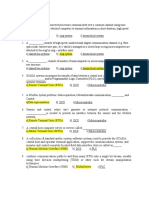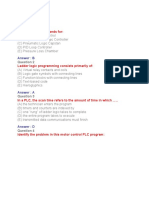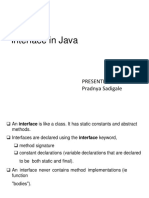0 ratings0% found this document useful (0 votes)
102 viewsJavaabstractclassmethods
An abstract class is a class that is declared with the abstract keyword. An abstract class cannot be instantiated, and can contain abstract methods that have no body. If a class contains an abstract method, then the class itself must be declared abstract. To use an abstract class, another class must inherit from it and implement all of its abstract methods. Abstract methods define a method signature but no body, and end with a semicolon instead of curly braces.
Uploaded by
pradnya sadigaleCopyright
© © All Rights Reserved
Available Formats
Download as PDF, TXT or read online on Scribd
0 ratings0% found this document useful (0 votes)
102 viewsJavaabstractclassmethods
An abstract class is a class that is declared with the abstract keyword. An abstract class cannot be instantiated, and can contain abstract methods that have no body. If a class contains an abstract method, then the class itself must be declared abstract. To use an abstract class, another class must inherit from it and implement all of its abstract methods. Abstract methods define a method signature but no body, and end with a semicolon instead of curly braces.
Uploaded by
pradnya sadigaleCopyright
© © All Rights Reserved
Available Formats
Download as PDF, TXT or read online on Scribd
You are on page 1/ 8
Pradnya Sadigale
A class which contains the abstract keyword in its
declaration is known as abstract class.
Abstract classes may or may not contain abstract
methods, i.e., methods without body ( public void
get(); )
But, if a class has at least one abstract method, then
the class must be declared abstract.
If a class is declared abstract, it cannot be
instantiated.
To use an abstract class, you have to inherit it from
another class, provide implementations to the
abstract methods in it.
If you inherit an abstract class, you have to provide
implementations to all the abstract methods in it.
Example of Abstract Class
public abstract class Employee
{
private String name;
private String address;
public Employee(String name, String address, int number)
{
System.out.println("Constructing an Employee");
this.name = name;
}
public double computePay()
{
System.out.println("Inside Employee computePay");
return 0.0;
}
}
Now lets try to instantiate the Employee
class in the following way −
public class AbstractDemo
{
public static void main(String [] args)
{
Employee e = new Employee("George W.“);
System.out.println("\n Call Employee ");
e.mailCheck();
}
}
Employee.java:46: Employee is abstract; cannot be instantiated
Employee e = new Employee("George W”);
^ 1 error
If you want a class to contain a particular method
but you want the actual implementation of that
method to be determined by child classes, you
can declare the method in the parent class as an
abstract.
abstract keyword is used to declare the method
as abstract.
You have to place the abstract keyword before
the method name in the method declaration.
An abstract method contains a method signature,
but no method body.
Instead of curly braces, an abstract method will
have a semoi colon (;) at the end.
Following is an example of the abstract method.
public abstract class Employee
{
private String name;
public abstract double computePay();
}
Declaring a method as abstract has two
consequences −
The class containing it must be declared as
abstract.
Any class inheriting the current class must
either override the abstract method or declare
itself as abstract.
Suppose Salary class inherits the Employee
class, then it should implement computePay()
public class Salary extends Employee
{
private double salary;
double computePay()
{
System.out.println("Computing salary " +
getName());
return salary/52;
}
}
You might also like
- LO 2 Apply Java Advanced Class Design and Object Oriented Design PrinciplesNo ratings yetLO 2 Apply Java Advanced Class Design and Object Oriented Design Principles24 pages
- Lecture_9 Abstract Classes and Abstract MethodsNo ratings yetLecture_9 Abstract Classes and Abstract Methods39 pages
- Session 1.8 - 1.9 Abstract_Class_in_Java (2)No ratings yetSession 1.8 - 1.9 Abstract_Class_in_Java (2)13 pages
- Lecture - 9 Abstract Classes and Abstract MethodsNo ratings yetLecture - 9 Abstract Classes and Abstract Methods35 pages
- Abstract Classes: Abstract Static Void Print WrongNo ratings yetAbstract Classes: Abstract Static Void Print Wrong11 pages
- Abstraction in Java: Abstract Classes and MethodsNo ratings yetAbstraction in Java: Abstract Classes and Methods2 pages
- Unit-III Methods and Inheritance in JavaNo ratings yetUnit-III Methods and Inheritance in Java47 pages
- Programming in Java: Abstract Class and InterfaceNo ratings yetProgramming in Java: Abstract Class and Interface23 pages
- Java Programming Tutorial With Screen Shots & Many Code ExampleFrom EverandJava Programming Tutorial With Screen Shots & Many Code ExampleNo ratings yet
- IGNOU PGDCA MCS 206 Object Oriented Programming using Java Previous Years solved PapersFrom EverandIGNOU PGDCA MCS 206 Object Oriented Programming using Java Previous Years solved PapersNo ratings yet
- Presented By: Dear Professor:: Seminar 1No ratings yetPresented By: Dear Professor:: Seminar 162 pages
- Experiment No. 02: DR D Y Patil School of Engineering & TechnologyNo ratings yetExperiment No. 02: DR D Y Patil School of Engineering & Technology3 pages
- Daily Monitoring Report26.04.20 by Class TeacherNo ratings yetDaily Monitoring Report26.04.20 by Class Teacher1 page
- Experiment No. 01: DR D Y Patil School of Engineering & TechnologyNo ratings yetExperiment No. 01: DR D Y Patil School of Engineering & Technology4 pages
- 1-Which of The Following Is Not Covered Under Mechanical Energy Domain?No ratings yet1-Which of The Following Is Not Covered Under Mechanical Energy Domain?6 pages
- Experiment No. 03: DR D Y Patil School of Engineering & TechnologyNo ratings yetExperiment No. 03: DR D Y Patil School of Engineering & Technology5 pages
- Experiment No. 05: DR D Y Patil School of Engineering & TechnologyNo ratings yetExperiment No. 05: DR D Y Patil School of Engineering & Technology6 pages
- Java Programming - Abstract Class & InterfaceNo ratings yetJava Programming - Abstract Class & Interface18 pages
- An Overview of MANET: Applications, Attacks and ChallengesNo ratings yetAn Overview of MANET: Applications, Attacks and Challenges10 pages
- Industrial Automation Unit V: Prepared By: Pradnya SadigaleNo ratings yetIndustrial Automation Unit V: Prepared By: Pradnya Sadigale31 pages
- Interface in Java: Presented By: Pradnya SadigaleNo ratings yetInterface in Java: Presented By: Pradnya Sadigale12 pages
- A Transducer Is An Element Which Converts The Measurand Into A Useful - SignalNo ratings yetA Transducer Is An Element Which Converts The Measurand Into A Useful - Signal4 pages
- Object Oriented Programming Methodology Using Java: Prof: Pradnya Sadigale (E&Tcdepartment)No ratings yetObject Oriented Programming Methodology Using Java: Prof: Pradnya Sadigale (E&Tcdepartment)39 pages
- The Simplex Method: Maximization: Simplex Method. The Simplex Method Was Developed by George Dantzig in 1946. It ProvidesNo ratings yetThe Simplex Method: Maximization: Simplex Method. The Simplex Method Was Developed by George Dantzig in 1946. It Provides3 pages
- University of Washington, Cse 154 Homework Assignment 7: AsciimationNo ratings yetUniversity of Washington, Cse 154 Homework Assignment 7: Asciimation4 pages
- Multibanking Online Transaction Processing Using Data Transfer Security ModelNo ratings yetMultibanking Online Transaction Processing Using Data Transfer Security Model25 pages
- Projects For Teaching Computer Organization and ArchitectureNo ratings yetProjects For Teaching Computer Organization and Architecture9 pages
- Experiment-7 //WAP To Check Whether A Grammar Is Left Recursive or Not, If So Remove ItNo ratings yetExperiment-7 //WAP To Check Whether A Grammar Is Left Recursive or Not, If So Remove It2 pages
- B.SC It: System Analysis and Design BCA Multiple Choice Questions IV SemNo ratings yetB.SC It: System Analysis and Design BCA Multiple Choice Questions IV Sem38 pages
- Test Cases of Calculator (Software Testing)No ratings yetTest Cases of Calculator (Software Testing)9 pages
- Module 5. Computer Security AND Case Study of Linux OsNo ratings yetModule 5. Computer Security AND Case Study of Linux Os8 pages
- Mastering C 2nd Edition Venugopal pdf download100% (2)Mastering C 2nd Edition Venugopal pdf download47 pages
- CSE332 Practice Questions Mid Summer2024No ratings yetCSE332 Practice Questions Mid Summer20244 pages
- Computer Organization: - Six Logical Units in Every ComputerNo ratings yetComputer Organization: - Six Logical Units in Every Computer17 pages
- Pipeline: Azure Data Factory Cheat Sheet by100% (1)Pipeline: Azure Data Factory Cheat Sheet by14 pages
- Data Structures and Algorithms Lab Journal - Lab 11: ObjectiveNo ratings yetData Structures and Algorithms Lab Journal - Lab 11: Objective5 pages
- LO 2 Apply Java Advanced Class Design and Object Oriented Design PrinciplesLO 2 Apply Java Advanced Class Design and Object Oriented Design Principles
- Abstract Classes: Abstract Static Void Print WrongAbstract Classes: Abstract Static Void Print Wrong
- Java Programming Tutorial With Screen Shots & Many Code ExampleFrom EverandJava Programming Tutorial With Screen Shots & Many Code Example
- IGNOU PGDCA MCS 206 Object Oriented Programming using Java Previous Years solved PapersFrom EverandIGNOU PGDCA MCS 206 Object Oriented Programming using Java Previous Years solved Papers
- Experiment No. 02: DR D Y Patil School of Engineering & TechnologyExperiment No. 02: DR D Y Patil School of Engineering & Technology
- Experiment No. 01: DR D Y Patil School of Engineering & TechnologyExperiment No. 01: DR D Y Patil School of Engineering & Technology
- 1-Which of The Following Is Not Covered Under Mechanical Energy Domain?1-Which of The Following Is Not Covered Under Mechanical Energy Domain?
- Experiment No. 03: DR D Y Patil School of Engineering & TechnologyExperiment No. 03: DR D Y Patil School of Engineering & Technology
- Experiment No. 05: DR D Y Patil School of Engineering & TechnologyExperiment No. 05: DR D Y Patil School of Engineering & Technology
- An Overview of MANET: Applications, Attacks and ChallengesAn Overview of MANET: Applications, Attacks and Challenges
- Industrial Automation Unit V: Prepared By: Pradnya SadigaleIndustrial Automation Unit V: Prepared By: Pradnya Sadigale
- A Transducer Is An Element Which Converts The Measurand Into A Useful - SignalA Transducer Is An Element Which Converts The Measurand Into A Useful - Signal
- Object Oriented Programming Methodology Using Java: Prof: Pradnya Sadigale (E&Tcdepartment)Object Oriented Programming Methodology Using Java: Prof: Pradnya Sadigale (E&Tcdepartment)
- The Simplex Method: Maximization: Simplex Method. The Simplex Method Was Developed by George Dantzig in 1946. It ProvidesThe Simplex Method: Maximization: Simplex Method. The Simplex Method Was Developed by George Dantzig in 1946. It Provides
- University of Washington, Cse 154 Homework Assignment 7: AsciimationUniversity of Washington, Cse 154 Homework Assignment 7: Asciimation
- Multibanking Online Transaction Processing Using Data Transfer Security ModelMultibanking Online Transaction Processing Using Data Transfer Security Model
- Projects For Teaching Computer Organization and ArchitectureProjects For Teaching Computer Organization and Architecture
- Experiment-7 //WAP To Check Whether A Grammar Is Left Recursive or Not, If So Remove ItExperiment-7 //WAP To Check Whether A Grammar Is Left Recursive or Not, If So Remove It
- B.SC It: System Analysis and Design BCA Multiple Choice Questions IV SemB.SC It: System Analysis and Design BCA Multiple Choice Questions IV Sem
- Module 5. Computer Security AND Case Study of Linux OsModule 5. Computer Security AND Case Study of Linux Os
- Computer Organization: - Six Logical Units in Every ComputerComputer Organization: - Six Logical Units in Every Computer
- Data Structures and Algorithms Lab Journal - Lab 11: ObjectiveData Structures and Algorithms Lab Journal - Lab 11: Objective









